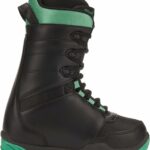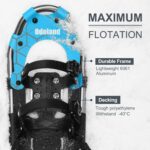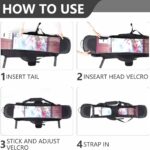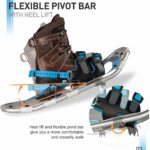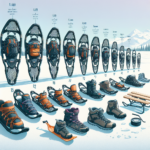So, you’ve just started snowboarding, and you’re already faced with a ton of questions, including “What size bindings do I need for my snowboard?” It can be quite confusing, as snowboard bindings come in various sizes, and picking the right one can make a huge difference in your overall experience on the slopes. This article aims to simplify this process for you and provide you with the essential information you need to make an informed decision. As you read on, you’ll find easy-to-understand guides on snowboard binding sizing, which will help you pair your snowboard with the perfect set of bindings.
Understanding Snowboard Bindings
What are Snowboard Bindings?
Snowboard bindings are an integral part of your snowboarding gear. They are essentially the link between your boots and the snowboard itself. They firmly secure your feet to the board and transmit your movements to the board. it. Each binding typically consists of a base plate, straps, and a highback which offers support to your ankles and calves.
Importance of Proper Bindings
The usefulness of properly fitting bindings cannot be overstated. They play a crucial role in ensuring snowboarding accuracy, control, and safety. They directly influence your ability to steer and control the snowboard. With the correct bindings, your movements are efficiently transferred to the board. They also help in keeping your feet comfortable, reducing fatigue from pressure points. Moreover, correctly fitted bindings can reduce the risk of injuries during falls and mishaps.
The Role of Binding Size in Snowboarding
Influence on Performance
Size plays a significant role in snowboarding performance. A proper fit helps in maximizing the power transfer from your body to the board. This in turn leads to more accurate control and improved performance while snowboarding. On the flip side, bindings that are either too large or too small can result in sloppy steering and reduced stability.
Impact on Safety
An incorrect binding size can increase the risk of snowboarding accidents and injuries. Loose bindings may not properly secure your feet, potentially causing slips during aggressive moves or jumps. On the contrary, overly tight bindings can prove to be restrictive and lead to bruises or even fractures.
Effect on Comfort
Comfort is essential for an excellent snowboarding experience. Bindings that are the wrong size can cause discomfort, soreness, and numbness. Over time, this can translate into fatigue and a poor snowboarding experience.
General Guidelines for Choosing Snowboard Bindings Size
Manufacturer’s Size Chart
The best starting point for determining the right bindings size is to consult the manufacturer’s size chart. Most snowboard makers offer comprehensive sizing recommendations based on your boots’ size.
Relating Boots Size with Bindings Size
In general, snowboard bindings and boots should be compatible. A broad rule of thumb is that your bindings should fit your boots snugly, without overhanging. If there is a significant difference in size, it may affect your ability to control the snowboard effectively.
Physical Testing and Measurements
Even with the manufacturer’s guidelines and general rules, it’s important to physically test your bindings. This involves strapping your boots into the bindings and checking for any looseness or tightness.
Factors to Consider When Deciding on Binding Size
Snowboarder’s Skill Level
Your skill level should factor into your decision when choosing binding size. Novice snowboarders may prefer larger bindings for their stability, while experienced snowboarders might choose smaller sizes for precision and control.
Riding Style and Terrain Preferences
Your choice of binding size should align with your snowboarding style and the terrain you frequently ride on. Different styles and terrains require different levels of control and flexibility, influencing the size of bindings you should go for.
Personal Comfort Preferences
Everyone has their own comfort preferences. Some snowboarders may prefer their bindings to be extra snug, while others might want a little bit of wiggle room. Understanding your comfort preference is key in deciding the right binding size.
Standard Measurements for Binding Sizes
Small Bindings Measurements
Small bindings are typically designed to fit boots sizes between 5 and 6.5. They are ideal for youth or individuals with smaller feet.
Medium Bindings Measurements
Medium bindings usually cater to boot sizes 7 to 8.5. They are suitable for most average-sized adults.
Large Bindings Measurements
Large bindings are designed for boot sizes 9 and above. These bindings are suitable for individuals with larger foot sizes.
How to Measure for Snowboard Bindings
Measuring Snowboarding Boots
To measure for bindings, you first need to know the size of your snowboarding boots. You can find this label on the tongue or side of the boot. Take note of both the numerical size and the letters denoting gender.
How to Measure Your Stance
Your stance refers to how far apart your bindings are. The general rule for stance width is about shoulder-width apart. Adjustments can be made depending on your preference for a wider or narrower stance.
Testing Bindings Fit on the Snowboard
Once you’ve got your measurements and have an idea of the right size bindings, it’s crucial to test how they fit on the board. The binding should sit flush with the snowboard, without the base plate hanging off the edges.
Possible Issues with Incorrect Binding Sizes
Decreased Performance
Snowboarders using bindings that are either too big or too small often report issues with maneuvering and control. This can directly impact performance and make snowboarding a lot less enjoyable.
Increased Risk of Injuries
The incorrect binding size can also lead to greater safety risks. The boarding community often reports accidents and injuries from a lack of control and security provided by improperly fitting bindings.
Reduced Comfort and Enjoyment
Bindings that don’t fit correctly can also lead to discomfort. Whether it’s because of overly tight straps or a base plate that doesn’t sit properly on the board, these issues can significantly impact your overall experience.
Different Types of Snowboard Bindings
Strap-In Bindings
Strap-in bindings are the most common type. They offer a high level of adjustability and control, which makes them a good all-around option for many snowboarders.
Rear-Entry Bindings
Rear-entry bindings are known for their convenience. They allow the rider to quickly slide their foot in and out, and provide a good level of comfort.
Step-In Bindings
Step-in bindings offer the highest level of convenience. They do have a drawback in that they typically offer less control and adjustability than their strap-in counterparts.
Advanced Sizes: Oversize and Undersize Bindings
Pros and Cons of Oversize Bindings
Oversize bindings do provide stability, they can be extra responsive which might not be ideal for beginners. They can also unnecessarily increase the board’s weight.
Practicality of Undersize Bindings
Undersize Bindings provide more freedom for maneuvers and tricks but compromise on stability which can be dangerous for less experienced riders.
When It’s About Personal Style
Sometimes your choice of binding size isn’t driven by practicality but by style. As long as your choice doesn’t significantly affect control, stability, and safety, it’s okay to prioritize aesthetics.
Tips and Tricks for Optimal Binding Fit
Strap Adjustments
Adjust the straps to achieve a snug, but not overly tight fit around your boot.
Board and Boot Compatibility Check
Ensure your boots and board are compatible, which influences your choice of binding size.
Trying Several Bindings Options before Purchase
Experiment and try different binding sizes and types before making the final decision to ensure you choose the best ones for you.
- What Snowboard Bindings Should I Get? - January 23, 2024
- What Size Screws For Snowboard Bindings? - January 23, 2024
- How To Snowmobile On Water? - January 23, 2024

